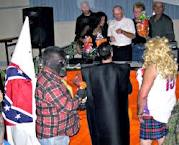The Royal Canadian Legion, originally known as the Canadian
Legion of the British Empire Services League was incorporated in
1926 and was an amalgamation of over a dozen veterans advocacy groups
that were active after the World War I.
According to the Legion’s website the goal of the original
organization was to “provide a strong voice for veterans and to advise
the government” . During the 1920s and into the Great Depression the Legion
become an outspoken advocate for improved pensions and other benefits for
veterans.
In 1930 while the country was spiraling into economic
depression the federal government, responding in no small measure to the
lobbying efforts of the Legion, passed the War Veterans Allowance
Act which granted pensions to war veterans over the age of sixty who were in
need of financial assistance.
However few Canadian Forces veterans today chose to join the Royal
Canadian Legion. Demographically and
culturally the Legion is losing its connectivity
to the military and veteran community.
While there are up to 800,000 Canadian Forces veterans in the
general population today who could automatically qualify for Legion membership
few have made the effort to take part in an organization that, until recently, was slow in redefining and refocusing itself
on the needs of the post Korean war generation of veterans.
“Today’s Legion is a victim of its own arrogance from the 1970s and
80s.” says former Master Corporal Ron Cundell, a disabled Canadian Forces veteran with several overseas
tours to his credit. “They always used to look down their nose at us younger
veterans-we did not count to them. Now since the creation of the veteran
ombudsman they want to be the spokesman for all veterans.”
With few modern veterans wanting to join, today’s Legion is rapidly losing
members.
Desperate for new “recruits” the Legion is opening up more fluid criteria for membership to non-veterans that would have been unthinkable in the past. In addition to former
members of the armed forces of Canada,
the United States
and other allied countries ordinary Legion membership is also available to
serving and former members of the coast guard, and any national
provincial or municipal police forces .
Further almost any person regardless of military or paramilitary
association can join the Legion as an associate member. Today a majority of
Legion membership, including many of its
administrative positions, are made up of people who never
spent a day in any uniform.
Almost anyone with a relative who could have traditionally qualified
for Legion membership can today become a Legion member themselves.
Otherwise, even without relatives who had served in the military, police or
coast guard, a person can still apply as an affiliate voting
member of the Legion. Even people who are not citizens of Canada can apply as an
affiliate non-voting member.
All categories of Legion membership can wear the Legion uniform and
are entitled to receive a series of special merit and service medals produced
solely by the Legion which can often be mistaken by the untrained eye as
authentic military medals.
Still this fluid criteria for membership has failed to fill
the Legions dwindling ranks. In its Report and Resolution from its 2008
Convention the Legion stated that nationally its efforts at acquiring new
members “have fallen short on our renewal goals and (we) are unable to
recruit enough new members to make up for the losses.”
Since 1993, Legion membership
has declined by over 35% from 512, 281 in 1993 to 373,
367 in 2007. In 2007 alone membership in the Legion declined
by an average of 3.92 percent
And while, at its inception, the legion prided itself as
an advocate for better compensation and treatment for First World War
Veterans, many of whom were still in their 20s and 30s, todays
Legion is walking hand in hand with the federal government as
they allowed for the elimination many of the benefits (including
disability pensions) that their organization once fought for.
“If our veterans organizations are going to be veterans
organizations then they are going to have to change into being totally relevant
to what is going on” said former Liberal veterans
affairs critic Rob Oliphant in a 2009 interview.
It is an opinion that is shared by retired Captain Sean Bruyea a veteran
advocate and a disabled Gulf War veteran who believes that
the Legion is far too willing to give the government and bureaucracy the
benefit of the doubt when new legislation is introduced.
“I think that the Legion especially with the New Veterans Charter
and the blank cheque that they gave to the bureaucracy has severely damaged
their credibility with the Canadian Forces Veteran” he says. “Also
I think the legion Command structure is completely counterproductive for not
allowing initiative and rapid change to be brought forth from their grassroots
level."

